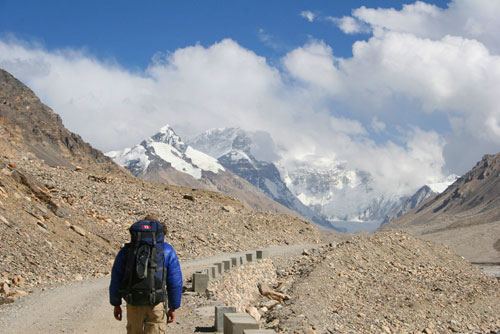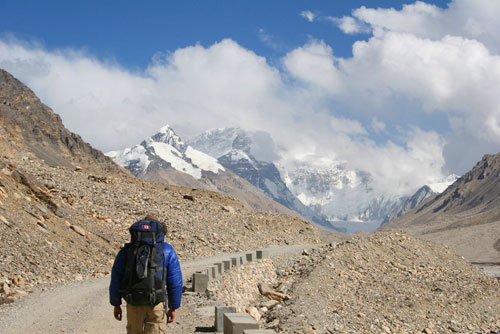Properly packing for a trip will take longer than haphazardly throwing things in a suitcase or backpack the night before. But having all your essentials purchased and packed a week or so before your trip will take the stress out of making it to the airport and any last minute goodbye phone calls.
Vagabondish is reader-supported. When you buy through links on our site, we may earn a small affiliate commission. Read our disclosure.
The first thing you should think about is what kind of bag you are going to throw all your stuff into. This ultimately depends on what type of trip you’re planning on taking.
Generally speaking, the choice boils down to two types of “hauling” equipment:
#1. A more traditional suitcase with wheels and a handle to allow for dragging through train stations and airports
or
#2. An internal frame backpacker’s backpack that, like the name says, you carry on your back.
Hell on Wheels
The first option may be good for the traveler who is flying into Paris and staying in Paris at the same hotel for the duration of the trip. They will only need to move to and from the airport or train station once and can leave the luggage unpacked in the room for the duration.

Perhaps Not the Best Luggage Choice © joka2000
That being said, few things are more frustrating than trying to run to make a train departure and having to weave in and out of slow moving and disoriented travelers dragging large suitcases behind them as if they were part of a Japanese game show and you were the contestant who will soon fall flat on your face. Then, when you get to your train, invariably these same travelers are trying to hoist their overloaded suitcase up to their travel partner in the train, who already has two or three other suitcases around them, which are blocking any movement or entrance to your car or seat. All of this only makes the hilarious scene of these travelers trying to maneuver a suitcase on two small wheels over the cobblestones and uneven walkways of Europe more enjoyable.
So … by now you may have guessed my choice in luggage.
The Backpacker’s Pack
On every trip I have ever taken – be it seven days or forty, one country or six – an internal frame backpack is what I use. This type of pack allows you to move about hands-free so you can keep an eye on that all important map and is for all intents and purposes just an extension of yourself. You’re free to hop on a train and find your seat or climb the stairs to your hotel room without the struggles of carrying a suitcase. Being hands-free also has its advantages when trying to walk down a moving train car in Italy. It may very well save you the embarrassment of landing in a local’s lap.
What to Look For
New suspension systems on these types of packs relieve a great deal of stress on the back, in turn making them much more comfortable, especially when you consider everything you own is inside it. If you are going to visit several locations and use public transportation to get there, this is the way to go.
Purchasing a pack that has easy access to its contents is important. Some people prefer a bunch of outer-pockets for separating their belongings and others like one big “sack” like pack that everything fits into. In any case you want to be able to get to your clean socks at the bottom of your bag without taking everything out of it and having to re-pack every time.
In terms of size I have found that 4500-5000 cubic inches (that’s how the capacity of these packs are measured and noted at the store) has been perfect for short or long trips. All-in-all I pack about the same for all trips (see the packing check list I have put together) and this size allows for a little extra room for souvenirs but not so much that I end up buying stuff just to fill it and end up overloaded. In fact 4500-5000 cubic inches really makes it hard to over-pack and that can make your trip much more comfortable. In addition, a pack this size usually falls within the carry-on limits for international flights making the whole disembark-and-find-your-bag fiasco a thing of the past. Just watch what you pack or you may lose your Swiss army knife or fingernail clippers. Buying such things once you land is worth the benefits of getting to your hotel quickly right after an 8 hour flight.
As for how much to spend, this can vary because of any number of factors; not the least of which is how much you can afford. That being said, I see no reason to spend more than 300 dollars US on a backpack like this. $200-300 will get you a pack that will last for many many trips and years and several models now have the option of adding extra storage by attaching supplemental pockets should the need arise.
The Final Decision
No matter how much you decide is the right amount to spend try the pack on in the store and ask the salesperson to fill it with weights. This will allow you to see how the pack fits and if it is the right size and shape for you. Most camping supply stores that carry internal frame backpacks will have large beanbag type sacks that can be put into the pack to simulate the weight of your clothes and travel items.
Try to find a specialty store in your area as these will have knowledgeable staff that understand the products and genuinely love what they do. This of course translates, usually, into a willingness to help you through the sale by answering all your questions. REI, Trail and Ski and Bass Pro shops (outdoor world) have always been my favorite stores to shop for packs and other equipment.
Lastly you may be asking why an internal frame pack and not the good old external backpacking packs. Simply put: external packs are outdated. They do not stay as close to your body, place added strain on your back, and tend to be much broader which makes moving down plane or train aisles difficult. The internal frame pack tends to be much more comfortable and maneuverable and with the latest designs you don’t have to worry about airflow to your back on hot days.
Taking the time to find the right type and size of pack is as important as getting the right pair of shoes. Remember that it will essentially be your home and best friend for a couple weeks (or longer) and you need to likewise feel comfortable in it and want to keep it around.



